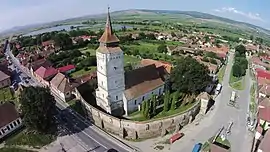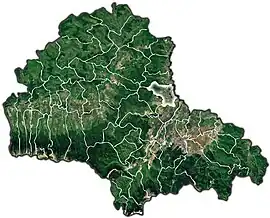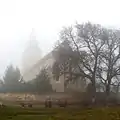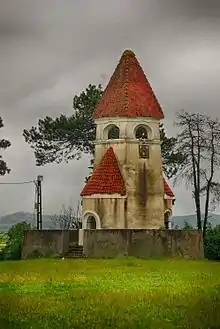Feldioara
Feldioara (German: Marienburg, [maˈʁiːənbʊʁk] ⓘ; Hungarian: Földvár or Barcaföldvár) is a commune in Brașov County, Transylvania, Romania, about 15 kilometres from the city of Brașov. It is composed of three villages: Colonia Reconstrucția (Bohntelep), Feldioara and Rotbav (Rothbach; Szászveresmart).
Feldioara | |
|---|---|
 Evangelic fortified church in Rotbav | |
 Location within the county | |
 Feldioara Location in Romania | |
| Coordinates: 45°49′0″N 25°35′30″E | |
| Country | Romania |
| County | Brașov |
| Government | |
| • Mayor (2020–2024) | Sorin Taus[1] (PNL) |
| Area | 75.97 km2 (29.33 sq mi) |
| Elevation | 389 m (1,276 ft) |
| Population (2011-10-31)[2] | 6,154 |
| • Density | 81/km2 (210/sq mi) |
| Time zone | EET/EEST (UTC+2/+3) |
| Postal code | 507065 |
| Vehicle reg. | BV |
| Website | www |
The commune is located in the east-central part of the county, in the northern reaches of the Burzenland. It is situated on the left bank of the Olt River, which mostly follows the border with Covasna County. The Bârsa River discharges into the Olt near Feldioara.
At the 2011 census, 88.8% of inhabitants were Romanians, 6.9% Hungarians and 3.5% Roma.
Feldioara has a medieval fortress long believed to have been built by the Teutonic Knights. However, more recent studies show that the Fortress in Feldioara was actually constructed by the local community. The name of the village comes from the Hungarian word földvár, which means "the clay fortress". The ruins of the fortress can still be seen today. The German name Marienburg means "fortress of the Virgin Mary".
 Feldioara fortress
Feldioara fortress Feldioara fortified church
Feldioara fortified church Rotbav fortified church
Rotbav fortified church
History
Between 1211 and 1225, Feldioara was the Teutonic Knights’ quarter, which will later become a peasant stronghold.[3] A 1439 document states that the civilians of Feldioara built this fortress “with great financial and physical expenses” in order to protect their families and possessions. The fortress withstood the Turkish invasion of 1421, but it was severely damaged by a second invasion in 1432. It took until 1457 to restore it.

During the battles of 1612, the armies led by Prince Gabriel Báthori conquered the fortress, and in September the Brașovian armies had Feldioara under siege for three days. On September 16, 1612, a battle was fought between the Hungarians, led by Báthori, and the Brașovians, led by mayor Michael Weiss. The Brașovians lost the fight, and Weiss was killed on the battlefield.[4]
The fortress – long out use for its original purpose – was used as a granary until 1838, when a major earthquake damaged it. After this event, even the fortress guardian left the building. Since then the fortress has lain in ruins.
Natives
See also
References
- "Results of the 2020 local elections". Central Electoral Bureau. Retrieved 9 June 2021.
- "Populaţia stabilă pe judeţe, municipii, oraşe şi localităti componenete la RPL_2011" (XLS). National Institute of Statistics.
- Ol' man river: geo-archaeological aspects of rivers and river plains, Morgan de Dapper et al, Ghent, Belgium: Academia Press in cooperation with Ghent University, Dept. of Archaeology and Ancient History of Europe, 2009, ISBN 978-90-382-1404-7, ISBN 90-382-1404-9
- "Kronstadts Übergabe kam nicht in Frage" (in German). October 19, 2012. Retrieved November 23, 2020.
